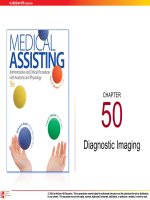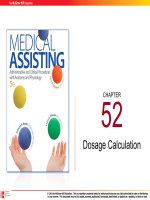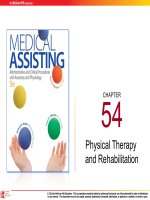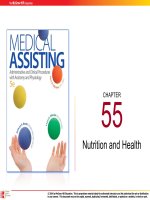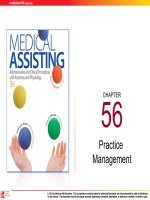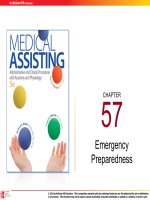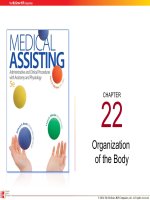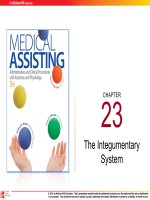Medical assisting Administrative and clinical procedures (5e) Chapter 55 Nutrition and health
Bạn đang xem bản rút gọn của tài liệu. Xem và tải ngay bản đầy đủ của tài liệu tại đây (1.13 MB, 59 trang )
CHAPTER
55
Nutrition and Health
© 2014 by McGraw-Hill Education. This is proprietary material solely for authorized instructor use. Not authorized for sale or distribution
in any manner. This document may not be copied, scanned, duplicated, forwarded, distributed, or posted on a website, in whole or part.
55-2
Learning Outcomes
55.1 Relate daily energy requirements to the
role of calories.
55.2 Identify nutrients and their role in health.
55.3 Implement a plan for a nutritious, wellbalanced diet and healthy lifestyle using
the USDA's guidelines.
55.4 Describe methods used to assess a
patient’s nutritional status.
© 2014 by McGraw-Hill Education. This is proprietary material solely for authorized instructor use. Not authorized for sale or distribution
in any manner. This document may not be copied, scanned, duplicated, forwarded, distributed, or posted on a website, in whole or part.
55-3
Learning Outcomes
55.5 Explain reasons why a diet may be
modified.
55.6 Identify types of patients who require
special
diets and the modifications required
for each.
55.7 Describe the warning signs, symptoms,
and treatment for eating disorders.
55.8 Educate patients about nutritional
requirements.
© 2014 by McGraw-Hill Education. This is proprietary material solely for authorized instructor use. Not authorized for sale or distribution
in any manner. This document may not be copied, scanned, duplicated, forwarded, distributed, or posted on a website, in whole or part.
55-4
Introduction
• Nutrition
– Utilization of food
and nutrients
– Five-part process
• Medical assistant
should understand
relationship
between nutrition
and health
• Intake
• Digestion
• Absorption
• Metabolism
• Elimination
© 2014 by McGraw-Hill Education. This is proprietary material solely for authorized instructor use. Not authorized for sale or distribution
in any manner. This document may not be copied, scanned, duplicated, forwarded, distributed, or posted on a website, in whole or part.
55-5
Daily Energy Requirements
• The body requires nutrients
– To provide energy
– To build, repair, and
maintain body tissues
– To regulate body
processes
© 2014 by McGraw-Hill Education. This is proprietary material solely for authorized instructor use. Not authorized for sale or distribution
in any manner. This document may not be copied, scanned, duplicated, forwarded, distributed, or posted on a website, in whole or part.
55-6
Metabolism
• Build, maintain and supply energy
• Phases
– Anabolism ~ builds tissues
– Catabolism ~ forms energy
• Requires nutrients
© 2014 by McGraw-Hill Education. This is proprietary material solely for authorized instructor use. Not authorized for sale or distribution
in any manner. This document may not be copied, scanned, duplicated, forwarded, distributed, or posted on a website, in whole or part.
55-7
Calories
• Kilocalorie (calorie)
– Measurement of energy
• Produced by food
• Expended
– Excess calories stored as fat
– Monitor food intake ~ calories/day
– Calories burned during physical activity
© 2014 by McGraw-Hill Education. This is proprietary material solely for authorized instructor use. Not authorized for sale or distribution
in any manner. This document may not be copied, scanned, duplicated, forwarded, distributed, or posted on a website, in whole or part.
55-8
Apply Your Knowledge
What is the difference between anabolism and
catabolism?
ANSWER: Anabolism converts nutrients into complex
substances needed to build body tissues. Catabolism
converts complex substances into simpler forms and
converts them into energy.
© 2014 by McGraw-Hill Education. This is proprietary material solely for authorized instructor use. Not authorized for sale or distribution
in any manner. This document may not be copied, scanned, duplicated, forwarded, distributed, or posted on a website, in whole or part.
55-9
Nutrients
• Needed for
– Energy
– Growth
– Repair
– Basic processes
• Contain calories
– Proteins
– Carbohydrates
– Fats
• Nutrients are
provided by
– Proteins
– Carbohydrates
– Fiber
– Lipids
– Vitamins
– Minerals
– Water
© 2014 by McGraw-Hill Education. This is proprietary material solely for authorized instructor use. Not authorized for sale or distribution
in any manner. This document may not be copied, scanned, duplicated, forwarded, distributed, or posted on a website, in whole or part.
55-10
Proteins (cont.)
• Functions
– Building and repairing cells and tissues
– Maintaining water balance
– Antibody production and disease
resistance
– Maintaining body heat
• 10% to 35% of total caloric intake daily
© 2014 by McGraw-Hill Education. This is proprietary material solely for authorized instructor use. Not authorized for sale or distribution
in any manner. This document may not be copied, scanned, duplicated, forwarded, distributed, or posted on a website, in whole or part.
55-11
Proteins
• Deficiency
– Weight loss/fatigue
– Malnutrition
– Dry skin
– Lower resistance to infection
– Interference with normal growth processes
© 2014 by McGraw-Hill Education. This is proprietary material solely for authorized instructor use. Not authorized for sale or distribution
in any manner. This document may not be copied, scanned, duplicated, forwarded, distributed, or posted on a website, in whole or part.
55-12
Proteins (cont.)
• Amino acids
– Used to make proteins
– Plant and animal sources
– Three types
• Essential amino acids
• Nonessential amino acids
• Conditional amino acids
© 2014 by McGraw-Hill Education. This is proprietary material solely for authorized instructor use. Not authorized for sale or distribution
in any manner. This document may not be copied, scanned, duplicated, forwarded, distributed, or posted on a website, in whole or part.
55-13
Carbohydrates
• Functions
– Energy (1gm = 4 calories) and heat
– Metabolize fats
– Keeps the body from using protein for
energy
• 45% to 65% of total caloric intake daily
• Deficiency
– Weight and protein loss
– Fatigue
© 2014 by McGraw-Hill Education. This is proprietary material solely for authorized instructor use. Not authorized for sale or distribution
in any manner. This document may not be copied, scanned, duplicated, forwarded, distributed, or posted on a website, in whole or part.
55-14
Carbohydrates (cont.)
• Simple sugars
• Complex
carbohydrates
– Long chains of
sugar units
– Types
• Starch
• Fiber
• Converted to
glucose for
energy
• Excess
– Stored in liver and
muscles cells
– Converted into and
stored as fat
© 2014 by McGraw-Hill Education. This is proprietary material solely for authorized instructor use. Not authorized for sale or distribution
in any manner. This document may not be copied, scanned, duplicated, forwarded, distributed, or posted on a website, in whole or part.
55-15
Fiber
• Functions
– Increases and softens the bulk of stool
– Absorbs wastes and toxins
– Decreases the rate of carbohydrate
breakdown and absorption
• 14 grams / 1000 calories
• Adequate water intake
• Soluble or insoluble
© 2014 by McGraw-Hill Education. This is proprietary material solely for authorized instructor use. Not authorized for sale or distribution
in any manner. This document may not be copied, scanned, duplicated, forwarded, distributed, or posted on a website, in whole or part.
55-16
Lipids
• Source of energy (1 gm = 9 calories)
• Triglycerides and compound lipids
• Functions – essential to growth and
metabolism
• 20% - 30% of daily calories
• Problems related to deficiency or excess
© 2014 by McGraw-Hill Education. This is proprietary material solely for authorized instructor use. Not authorized for sale or distribution
in any manner. This document may not be copied, scanned, duplicated, forwarded, distributed, or posted on a website, in whole or part.
55-17
Lipids (cont.)
• Saturated fats
– Animal sources
– Solid at room
temperature
• Unsaturated fats
– Liquid at room
temperature
– Vegetable oils
• Polyunsaturated
• Monounsaturated
• Trans fats
– Formed during
hydrogenation
– Zero consumption
© 2014 by McGraw-Hill Education. This is proprietary material solely for authorized instructor use. Not authorized for sale or distribution
in any manner. This document may not be copied, scanned, duplicated, forwarded, distributed, or posted on a website, in whole or part.
55-18
Lipids (cont.)
• Cholesterol
• Lipid levels
– Sources ~ liver and
dietary
– Cholesterol and
triglycerides
– Essential to health
– Lipoproteins
• Cell membrane
• Steroid hormones
and vitamin D
• Constituent of bile
• Low-density (LDL)
• High-density (HDL)
© 2014 by McGraw-Hill Education. This is proprietary material solely for authorized instructor use. Not authorized for sale or distribution
in any manner. This document may not be copied, scanned, duplicated, forwarded, distributed, or posted on a website, in whole or part.
55-19
Vitamins
• Organic substances
– Essential for normal growth and
maintenance
– Essential for resistance to infection
• Absorbed through digestive tract
• Water- or fat-soluble
© 2014 by McGraw-Hill Education. This is proprietary material solely for authorized instructor use. Not authorized for sale or distribution
in any manner. This document may not be copied, scanned, duplicated, forwarded, distributed, or posted on a website, in whole or part.
55-20
Minerals
• Natural, inorganic substances
– Build and maintain tissues
– Carry out life functions
• Major– needed in large quantities
• Trace – needed in small amounts
• Absorbed in the intestines
© 2014 by McGraw-Hill Education. This is proprietary material solely for authorized instructor use. Not authorized for sale or distribution
in any manner. This document may not be copied, scanned, duplicated, forwarded, distributed, or posted on a website, in whole or part.
55-21
Minerals
• RDAs
– Calcium ~ 800 to
1200 mg
– Iron ~ 10 to 15 mg
– Iodine ~ 150 mcg
– Zinc ~ 12 to 15 mg
– Magnesium
• 280 mg – women
• 350 mg – men
– Phosphorous ~ 800 mg
– Selenium
• 55 mcg – women
• 10 mcg – men
© 2014 by McGraw-Hill Education. This is proprietary material solely for authorized instructor use. Not authorized for sale or distribution
in any manner. This document may not be copied, scanned, duplicated, forwarded, distributed, or posted on a website, in whole or part.
55-22
Minerals
• Safe and adequate intake
– Copper ~ 1.5 to 3.0 mg
– Fluoride ~ 1.5 to 4.0 mg
– Chromium ~ 50 to 200 mg
– Manganese ~ 2 to 5 mg
– Molybdenum ~ 75 to 250 mcg
© 2014 by McGraw-Hill Education. This is proprietary material solely for authorized instructor use. Not authorized for sale or distribution
in any manner. This document may not be copied, scanned, duplicated, forwarded, distributed, or posted on a website, in whole or part.
55-23
Water
• 65% of body weight
• Functions
– Maintains fluid balance
– Lubricates moving
parts
– Dissolves chemicals
and nutrients
– Aids in digestion
– Transports nutrients
and secretions
– Flushes out wastes
– Regulates body
temperature
© 2014 by McGraw-Hill Education. This is proprietary material solely for authorized instructor use. Not authorized for sale or distribution
in any manner. This document may not be copied, scanned, duplicated, forwarded, distributed, or posted on a website, in whole or part.
55-24
Water (cont.)
• Fluid balance – intake should equal output
• Dehydration
– Inadequate intake
– Increased loss
• Educate patients about
when to increase fluids
© 2014 by McGraw-Hill Education. This is proprietary material solely for authorized instructor use. Not authorized for sale or distribution
in any manner. This document may not be copied, scanned, duplicated, forwarded, distributed, or posted on a website, in whole or part.
55-25
Principal Electrolytes and Nutrients of
Special Interest
• Electrolytes
– Sodium ~ 2.4 G or less
– Potassium ~ 1600 to 2000 mg
– Chloride ~ 2.4 G or less
• Antioxidants – chemical
agents that neutralize
free radicals
© 2014 by McGraw-Hill Education. This is proprietary material solely for authorized instructor use. Not authorized for sale or distribution
in any manner. This document may not be copied, scanned, duplicated, forwarded, distributed, or posted on a website, in whole or part.
